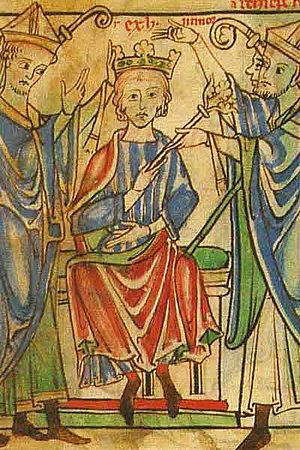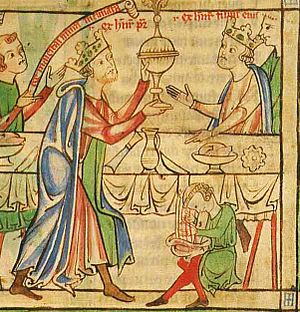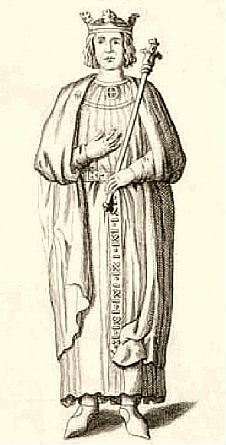Henry the Young King facts for kids
Quick facts for kids Henry the Young King |
|
|---|---|

Illumination of the coronation of Henry in the Becket Leaves (c.1220-1240).
|
|
| Junior king of England | |
| Reign | 14 June 1170 – 11 June 1183 |
| Coronation | 14 June 1170 |
| Senior king | Henry II |
| Born | 28 February 1155 London, England |
| Died | 11 June 1183 (aged 28) Castle of Martel, Lot, France |
| Spouse | |
| Issue | William |
| House | Plantagenet / Angevin |
| Father | Henry II, King of England |
| Mother | Eleanor, Duchess of Aquitaine |
Henry the Young King (born 28 February 1155, died 11 June 1183) was the oldest son of Henry II of England and Eleanor of Aquitaine who lived past childhood. From 1170, he held important titles like King of England, Duke of Normandy, and Count of Anjou.
Henry was the only English king since the Norman Conquest to be crowned while his father was still alive. However, he was unhappy because his father would not give him real power to rule. He died at age 28, six years before his father. This meant his brother Richard became the next king.
Contents
Early Life and Coronation

Not much is known about Henry's early years before his marriage and coronation. He had an older brother, William, who died young. His younger siblings included Richard and John, who both later became kings.
In June 1170, when Henry was fifteen, he was crowned king. This was a tradition from the French Capetian dynasty. They were the formal overlords of his father's lands in Europe. Henry was known as "Henry the Young King" to tell him apart from his father. Since he never ruled alone, he is not counted in the official list of English kings.
A Popular Tournament Star
Henry the Young King was not very interested in the daily tasks of running a government. This made him different from his father and younger brothers. Many historians believe his father did not give him enough power.
However, Henry was very popular in his time. He loved tournaments, which were like medieval sports competitions. His biography, the History of William Marshal, says he was always competing in tournaments across France between 1175 and 1182. He spent a lot of money on his team of knights. For example, he spent over £200 a day at a tournament in Lagny-sur-Marne in 1179.
Even though he did not have political power, his support for tournaments made him famous across Europe. People at the time felt that when he died in 1183, it was a sad moment for knights and chivalry. Some historians now argue that Henry was a capable person. They believe he was just frustrated because his father would not give him his own lands or responsibilities.
Political Events and Conflicts

Young Henry played a part in the politics of his father's rule. In 1160, when he was five, he was engaged to Margaret of France. She was the daughter of King Louis VII of France. This marriage was meant to settle a land dispute between their families. Henry II quickly arranged the marriage so he could take control of some castles. This led to a border war between the two kings.
Henry II had wanted to crown his son earlier, but there were delays. Finally, Henry was crowned on 14 June 1170 at Westminster Abbey. It was a calculated move that Margaret of France was not crowned with him. This angered King Louis VII, who attacked the Norman border. Eventually, the two kings made peace.
Young Henry and Margaret were officially married on 27 August 1172. Henry, now seventeen, was crowned King of England a second time, this time with Margaret, at Winchester Cathedral.
The Great Revolt
In 1173, Young Henry had a major disagreement with his father. Chroniclers say he was frustrated because his father gave him no lands to rule and not enough money. This led to a big rebellion against Henry II. Many powerful nobles from different regions joined Young Henry.
The revolt of 1173–1174 almost removed Henry II from power. But his father was saved by loyal nobles and by capturing William the Lion, the King of Scotland. After his mother, Eleanor of Aquitaine, was captured and the rebellion failed, Young Henry sought peace. He received more money and spent the next seven years mostly enjoying tournaments.
In 1179, he represented his father at the coronation of Philip II of France in Reims. He played an important role in the ceremony and the celebration tournament.
His affairs became difficult in 1182. He had a falling out with William Marshal, who was the leader of his tournament team. Henry sent his wife, Margaret, to the French court in early 1183. This was likely to keep her safe during an upcoming war with his brother, Richard.
Margaret gave birth to a son named William in 1177, but the baby died just three days later.
Death and Burial
Henry the Young King died at age 28 in the summer of 1183. He was fighting against his father and his brother Richard in Limousin, France. He had been taking money from local monasteries to pay his soldiers. He became sick with dysentery in early June.
As he grew weaker, he was taken to Martel. On 7 June, it was clear he was dying. He made a will and received his last religious rites. He had taken a crusader's vow, so he gave his cloak to his friend William Marshal. He asked William to take the cloak to the Holy Sepulchre in Jerusalem.
On his deathbed, he wanted to make peace with his father. But King Henry, fearing a trick, refused to see him. Henry the Young King died on 11 June, holding a ring his father had sent as a sign of forgiveness. His father later said, "He cost me much, but I wish he had lived to cost me more."
After Henry's death, his mother and friends tried to have him recognized as a saint. His body was taken north to Normandy. Henry had asked for his internal organs to be buried at Charroux Abbey, and the rest of his body at Rouen Cathedral.
During the funeral procession, there were large and emotional crowds wherever his body stopped. At Le Mans, the local bishop buried the body in his cathedral to calm the public. But the dean of Rouen later won a lawsuit to move the body. So, Henry the Young King was finally buried in Rouen Cathedral as he had wished.

His tomb is in Rouen Cathedral, across from the tomb of his younger brother, Richard I of England. His brothers Richard and John both became King of England after him.
Appearance and Character
A poem from 1170 describes Henry at his coronation. It says the fifteen-year-old prince was very handsome. He was tall and well-built, with broad shoulders and a long, elegant neck. He had pale, freckled skin, bright blue eyes, and thick reddish-gold hair.
Both Henry and Richard were described as tall and impressive. Henry was known for being gentle, generous, and kind. He was cheerful and friendly, making friends easily. He was also brave in battle and loved sports.
Cultural Depictions
- Henry was played by Riggs O'Hara in the 1964 film Becket.
- He was also played by Alan Cox (as a young boy), Dominic Savage (as a teenager), and Kevin McNally (as an adult) in the 1978 BBC TV series The Devil's Crown. This show told the story of his father's and brothers' reigns.
Genealogical table
: Bold borders indicate legitimate children of English monarchs
| Baldwin II King of Jerusalem |
Fulk IV Count of Anjou |
Bertrade of Montfort | Philip I King of France |
William the Conqueror King of England r. 1066–1087 |
Saint Margaret of Scotland | Malcolm III King of Scotland |
|||||||||||||||||||||||||||||||||||||||||||||||||||||||||||||||||||||||||||||||||||||||||||
| Melisende Queen of Jerusalem |
Fulk V King of Jerusalem |
Eremburga of Maine | Robert Curthose | William II King of England r. 1087–1100 |
Adela of Normandy | Henry I King of England r. 1100–1135 |
Matilda of Scotland | Duncan II King of Scotland |
Edgar King of Scotland |
Alexander I King of Scotland |
David I King of Scotland |
||||||||||||||||||||||||||||||||||||||||||||||||||||||||||||||||||||||||||||||||||||||
| Sibylla of Anjou | William Clito | Stephen King of England r. 1135–1154 |
Geoffrey Plantagenet Count of Anjou |
Empress Matilda | William Adelin | Matilda of Anjou | Henry of Scotland |
||||||||||||||||||||||||||||||||||||||||||||||||||||||||||||||||||||||||||||||||||||||||||
| Margaret I | Philip of Alsace Count of Flanders |
Louis VII King of France |
Eleanor of Aquitaine | Henry II King of England r. 1154–1189 |
Geoffrey Count of Nantes |
William FitzEmpress | Malcolm IV King of Scotland |
William the Lion King of Scotland |
|||||||||||||||||||||||||||||||||||||||||||||||||||||||||||||||||||||||||||||||||||||||||
| Baldwin I Latin Emperor |
Isabella of Hainault | Philip II King of France |
Henry the Young King | Matilda Duchess of Saxony |
Richard I King of England r. 1189–1199 |
Geoffrey II Duke of Brittany |
Eleanor | Alfonso VIII King of Castile |
Joan | William II King of Sicily |
John King of England r. 1199–1216 |
||||||||||||||||||||||||||||||||||||||||||||||||||||||||||||||||||||||||||||||||||||||
| Louis VIII King of France |
Otto IV Holy Roman Emperor |
Arthur I Duke of Brittany and Eleanor Fair Maid of Brittany |
Blanche of Castile Queen of France |
Henry III King of England r. 1216–1272 |
Richard of Cornwall King of the Romans |
Joan Queen of Scotland |
Alexander II King of Scotland |
||||||||||||||||||||||||||||||||||||||||||||||||||||||||||||||||||||||||||||||||||||||||||
Images for kids
See also
 In Spanish: Enrique el Joven para niños
In Spanish: Enrique el Joven para niños


